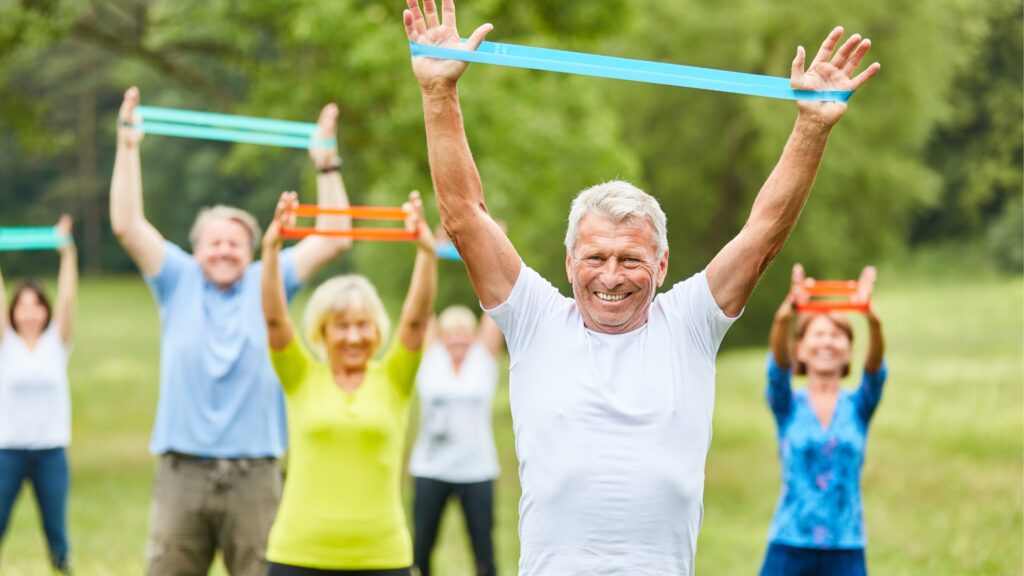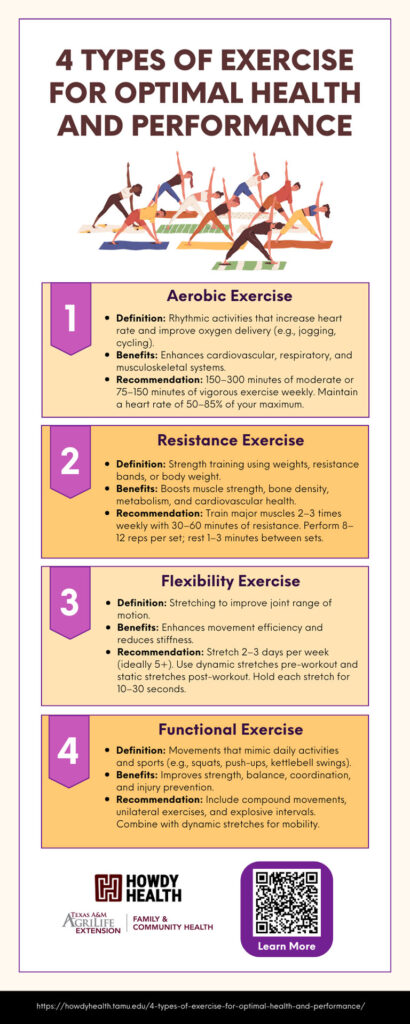Whether you’re just getting started or trying to up your exercise game, these four types of exercise are a must for optimal health and performance. These exercises can be done in separate sessions, but they can also be combined throughout your week to create an effective and time-efficient routine.
1. Aerobic exercise
Aerobic exercise, also called cardiorespiratory activity, is any type of activity you do rhythmically and steadily that makes you breathe harder and your heart pump faster. It uses oxygen to give your body energy and helps your heart and lungs work better at delivering oxygen to your muscles. Examples include jogging, cycling, swimming, or brisk walking.1 Research supports that aerobic exercise provides beneficial impacts to the human body by influencing the cardiovascular-, respiratory -, musculoskeletal-, and joint systems.2
Recommendation
Frequency & Intensity
- Aim for 150–300 minutes of moderate exercise weekly (walking, cycling, swimming).
- Alternatively, do 75–150 minutes of vigorous exercise (running, jump rope, fast cycling).
- Mix moderate and vigorous activities for variety and benefits.
- Stay consistent by spreading workouts across the week.
- Exceed 300 minutes for extra health perks.
- Target 50–85% of your maximum heart rate (this is called your target heart rate) during exercise.
- Beginners should aim for 50–70% for a safe start.
- Regular exercisers can aim for 70–85% to build endurance and improve health.1,3,4
2. Resistance exercise
Resistance exercise, also called strength training, involves exercising by making your muscles work against an external force, such as weights, resistance bands, or your own body weight. Resistance exercise can improve strength, bone density, metabolism, and support overall health. Resistance training has been found to increase lean body mass, reducing fat mass, and increase muscle metabolic properties – all of which may improve cardiovascular health, produce improvements in blood glucose, and prevent declines in functional ability.5
Recommendation
- Frequency & Intensity: Train major muscle groups 30–60 minutes weekly of resistance exercise. Use moderate weights (40–60% max).5,6
- Volume: Perform 8–12 reps per set until fatigue; aim for 1–3 sets of 8–10 key exercises.5
- Rest & Recovery: Rest 1–2 minutes for lighter loads, 2–3 minutes for heavier loads.6
- Technique & Progression: Maintain proper form to prevent injury. Gradually increase resistance, sets, or frequency to progress. Heavy weights with fewer reps build strength; lighter weights with higher reps improve endurance.5
3. Flexibility exercise
Flexibility exercises, sometimes referred to as stretching exercises, help improve the range of motion of your joints, allowing them to move fully. This involves stretching muscles and connective tissues. The ability to move through a full range of motion depends on factors such as the structure of the joint itself, as well as the strength and number of the ligaments and muscles that support and surround it. Flexibility makes everyday movements like reaching, bending, and turning easier, and is important for physical activities and sports.4,7,8,9
There are two main types of stretching, static and dynamic, that can help increase your flexibility.
Static stretching involves slowly stretching a muscle or tendon group and holding the position for a set amount of time. Examples of static exercises include cross arm stretch, standing calf stretch, standing quadricep stretch, seated hamstring stretch, and butterfly stretch.
Dynamic stretching involves gradually moving from one body position to another while increasing range of motion. Examples of dynamic exercises include leg swings, torso twist, arm circles, and walking lunges.
Recommendation
For substantial health benefits, strive for the following:
- Stretch Regularly: Stretch 2–3 days weekly, ideally 5+ for better flexibility.
- Timing Matters: Do dynamic stretches pre-workout; use dynamic and static stretches post-workout for flexibility and recovery.
- Target Major Muscle/Joint Groups: Stretch neck, shoulders, chest, back, hips, and legs.
- Proper Stretching Technique: Stretch to mild discomfort, not pain; avoid bouncing.
- Stretch Duration: Hold each stretch 10–30 seconds (30–60 seconds for older adults); repeat 2–4 times per muscle group.7,8,9,10,11,12,13
4. Functional exercise
Functional exercise, also called functional fitness training, is all about doing exercises that help you perform everyday tasks and/or improve your sports performance more easily and safely. Functional training enhances strength, balance, flexibility, and endurance in ways that directly improve daily movement and sports performance.
Functional exercises typically use compound movements, engaging multiple muscle groups, and emphasizing stability and core engagement to maintain proper posture and balance. It focuses on movements that you use in real life, like lifting groceries, reaching up to a shelf, bending down to pick things up, or squatting to sit in a chair, as well as activities commonly used in sports, like sprinting, striking, jumping, or moving side-to-side. The idea is that the more your workouts resemble these real-life and sports-related actions, the better you’ll be at them. This type of training improves things like balance, coordination, agility, and the smoothness of your movements—skills that are useful for both daily activities and sports. It also includes exercises that help you sense where your body is in space, which makes you more stable and in control.14,15,16
Examples of functional exercises include squats, lunges, deadlifts, push-ups, loaded carries, bent-over rows, step-ups, jump squats, and kettlebell swings. They also include exercises that challenge your balance and body awareness. Unilateral exercises (movements that use one limb) are often used to challenge your balance and stability and strengthen your core. Examples of unilateral exercises include standing on one leg with your eyes closed, single-leg squats, single-leg deadlifts, single-arm shoulder press, and single-arm row. Yoga poses and Tai-Chi movements may also be used as part of functional fitness training. Research shows that integrating functional exercises can boost mobility, reduce injury risk, and improve overall physical function.14,15
Recommendation
For substantial health benefits, strive for the following:
- Functional Strength Training: Focus on compound movements (squats, lunges, deadlifts) for better muscle power and real-life action benefits.
- Functional Balance & Stability: Include unilateral exercises (step-ups, split squats) to enhance balance, coordination, and injury prevention.
- Functional Endurance & Power: Swap steady-state cardio for intervals that include short bursts of explosive movement, such as jump squats or kettlebell swings.
- Functional Flexibility & Mobility: Use dynamic stretches pre-workout and static stretches post-workout to improve mobility and reduce stiffness.14,15,16,17
By making these small shifts in your existing routine, you can train your body to move better in everyday life while still improving overall fitness.
Making it happen
You don’t need to spend extra hours working out to benefit from these four types of exercise, just adjust what you’re already doing. You may be surprised to find that you’re already incorporating some of these types of exercise in your routine. Assess your routine to check for gaps in your current workout plan. Maximize your time and reduce boredom by “stacking exercises you need with exercises you already do.”14 Find ideas here for how to incorporate aerobic, resistance, flexibility, and functional exercises into your workout routine.
Infographic
Download the PDF or share the image below to help others learn more about the 4 types of exercise for optimal health and performance.
4 Types of Exercise for Optimal Health and Performance – Infographic (pdf)
References
- Millstein, R. Aerobic Exercise. In: Gellman, M.D. (eds) Encyclopedia of Behavioral Medicine, 2020. Springer, Cham. https://doi.org/10.1007/978-3-030-39903-0_1087.
- Permadi, A. The benefits of aerobic training for improving quality of life: A Critical Review of Study 4. 57-60, 2019. DOI: 10.22225/wmj.4.2.1016.57-60.
- Johns Hopkins Medicine. Understanding your target heart rate. November 3, 2021. Accessed August 12, 2024. https://www.hopkinsmedicine.org/health/wellness-and-prevention/understanding-your-target-heart-rate.
- U.S. Department of Health and Human Services. Physical Activity Guidelines for Americans, 2nd edition. Washington, DC: U.S. Department of Health and Human Services; 2018.
- Paluch, AE, et al. “Resistance exercise training in individuals with and without cardiovascular disease: 2023 update: A scientific statement from the American Heart Association.” Circulation, vol. 149, no. 3, 16 Jan. 2024, https://doi.org/10.1161/cir.0000000000001189.
- Medicine American College of Sports Medicine. Resistance training for health and fitness; 2013, Accessed January 31, 2025.
- Bushman, Barbara A. Ph.D., FACSM. Flexibility Exercises and Performance. ACSM’s Health & Fitness Journal 20(5):p 5-9, September/October 2016. | DOI: 10.1249/FIT.0000000000000226. Accessed January 31, 2025 https://journals.lww.com/acsm-healthfitness/fulltext/2016/09000/flexibility_exercises_and_performance.4.aspx.
- Committee on Fitness Measures and Health Outcomes in Youth; Food and Nutrition Board; Institute of Medicine; Pate R, Oria M, Pillsbury L, editors. Fitness Measures and Health Outcomes in Youth. Washington (DC): National Academies Press (US); 2012 Dec 10. 7, Health-Related Fitness Measures for Youth: Flexibility. Available from: https://www.ncbi.nlm.nih.gov/books/NBK241323/.
- Gibson, Ann L., et al. Advanced Fitness Assessment and Exercise Prescription. ninth ed., Human Kinetics, 2025. Accessed January 30, 2025 at https://books.google.com/books?hl=en&lr=&id=Z_vxEAAAQBAJ&oi=fnd&pg=PR1&dq=definition+of+flexibility+exercise
&ots=tzD4V1E0N2&sig=tqqq1y5ptgS20vTK5-UhVa1uPgg#v=onepage&q=definition%20of%20flexibility%20exercise&f=false. - Ferguson B. ACSM’s Guidelines for Exercise Testing and Prescription 9th Ed. 2014. J Can Chiropr Assoc. 2014 Sep;58(3):328. PMCID: PMC4139760.
- American College of Sports Medicine. Stretching and flexibility guidelines update, March 18, 2021. Accessed January 30, 2025. Available: https://www.acsm.org/blog-detail/acsm-certified-blog/2021/03/18/stretching-and-flexibility-guidelines-update.
- American College of Sports Medicine. A road map to effective muscle recovery. Accessed January 30, 2025. Available https://www.acsm.org.
- Westport Weston YMCA. Stretching Guidelines. Accessed January 30, 2025. Available https://www.westpoty.org
- DeSimone, Grace T. B.A., ACSM-CPT, ACSM-GEI. SHAREABLE RESOURCE: Stack Your Workouts. ACSM’s Health & Fitness Journal 27(2):p 4-5, 3/4 2023. | DOI: 10.1249/FIT.0000000000000838. Available: https://journals.lww.com/acsm-healthfitness/fulltext/2023/03000/shareable_resource__stack_your_workouts.3.aspx
- Boyle, Michael. New Functional Training for Sports 2nd Edition. Human Kinetics Publishers, 2016. Available: https://books.google.com/books?hl=en&lr=&id=U_IuDAAAQBAJ&oi=fnd&pg=PR1&dq=functional+fitness+training+
definition&ots=Rz-tw06y0i&sig=i2Fz_Ldu2Mfw7lubvSSLLge-C7o#v=onepage&q&f=false - Liu, Cj., Shiroy, D.M., Jones, L.Y. et al. Systematic review of functional training on muscle strength, physical functioning, and activities of daily living in older adults. European Review of Aging & Physical Activity 11, 95–106 (2014). https://doi.org/10.1007/s11556-014-0144-1.
- Golden, N. What is steady-state cardio. National Academy of Sports Medicine. Accessed January 31, 2025. https://blog.nasm.org/what-is-steady-state-cardio.



